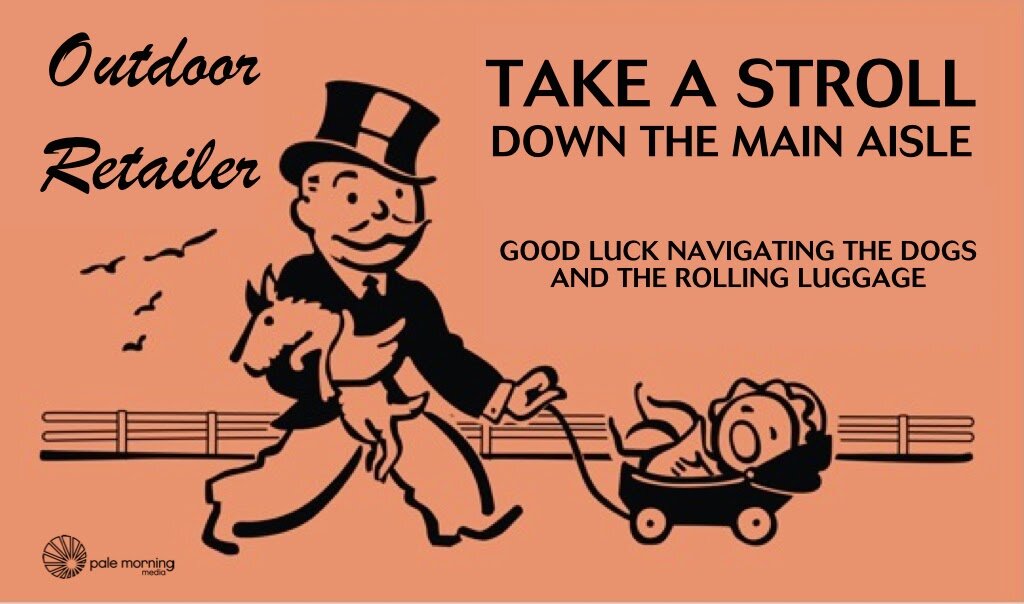Around our place, there was a Halloween-y surge in haunting chatter this week about some prospective regional ‘rep’ shows and their anticipated dates. To me, that chatter came in the form of numerous after-dark texting exchanges. But as with most late night texting, sometimes the details can be a little loose, a bit blurry … or even totally incorrect. For instance, one after-midnight missive broke the (false) news to me that OR would be moving to New York City in 2016.
Pause. Sip. Scratch. Hmm
It wasn’t true, of course. The world’s biggest gear closet isn’t headed to the Big Apple. But in a world full of fewer and fewer surprises every day, when you hear a rumor … it pays to wrap your head around it, even briefly.
So, what if it were true? What would a full-scale Outdoor Retailer show in New York City show actually look like? Would it be terrible? Would it be awesome? Would it be the ... same?
1. First, find Hell’s Kitchen: The most likely landing place for an OR show in NYC would be the Jacob Javits Convention Center, which is a pretty sizable spot on the Lower West Side. Facing the Hudson River, it’s convenient (in a New York way) by being about two seconds from the Lincoln Tunnel and two minutes from Penn Station. Sizewise, it's definitely comparable to the current OR digs, with 660 thousand square feet of exhibition space (two floors) and a hundred thousand feet or so of meeting space. The current home for the OR show clocks in at 679,000 square feet. Check.
2. Would it tougher on exhibitors? One of the keys to OR show attendance is appealing to exhibitors/attendees within a day's drive of the show. Interestingly, based on a search of OIA member data –- a fairly quick and decent way to spotlight exhibitors who also are committed enough to support broader advocacy efforts –- it’s actually kind of a toss-up. Utah has 67 OIA members, while New York has 63. Broaden that a bit to include the heavy hitter (no pun intended) of Colorado, and you bolster Utah’s hosting appeal by hitting the final tally of 266 OIA members. But it goes both ways -- when you stack it up for the Cold Coast with New England, Pennsylvania, Maryland and North Carolina, you end up with a robust 269 OIA members. Hmmm.
3. What about the Salt Palace’s infamous “show dogs”? No problem kids! In NYC, they got Crif Dogs.
4. But honestly, is New York ‘outdoor enough’? Hey, I love the West. I was born there, raised there, and have spent a lot of time falling down and running into things out there. It’s big, it’s bad, it’s rad and nobody will ever deny that. But to draw a line at the Mississippi and assume that one side is outdoor worthy and the other isn’t … well, those are the pants that make your brain look dim. Besides, New York is certainly on par with (if not far more outdoorsy a choice than) Las Vegas ... currently the top favorite among pundits for an alternate location to SLC.
5. Stepping through the Venture Out looking glass? To have a semi-permanent spot on one of the world's biggest stages for fashion tastemakers could have a lasting effect on the blend of product in the Outdoor Industry. For instance, in the heart of the Rocky Mountains, leather wafflestompers and 12-pound woolen backpacks are just a quirky subset of the ever-monochromatic Outdoor market … but in an alternate NYC-show future, Outdoor Retailer might evolve to be just the opposite, with a sea of five-panel hats and mom-jean-friendly designer brands surrounding a comfy, kitschy little area in the back pavilion tents where they sell things like “skis” and “kayaks.”
6. Could it significantly boost diversity? With a current trade show demographic that’s whiter than a GOP debate crowd, the Outdoor Industry doesn’t just want diversity: it needs it. And not just for growth, but for the long term survival of "outdoor" as more than just a theme for Nike's new pop-up store in Nolita. Hosting the OR show in the multi-cultural nexus of New York City would jump start that process by changing the average profile of the local, the interested, the attending, the employed, and the entrepreneurial. That change, in turn, would lead to a far more diverse base of company leaders, thought leaders and ... yes, eventually ... consumers.
7. Would it be a shot in the arm for the Outdoor Industry’s DC lobbying efforts? Imagine this: a rescheduled Capitol Summit held directly following the OR Summer Market Show, during which the OIA could stage “A Hike on Washington” from NYC to the Capitol steps to demand a return of respect and permanent funding for the Land and Water Conservation Fund. Hypothetically, of course.
8. How much would it grow the working media list? Double? Maybe triple? If you’ve got the time sometime, do a little number crunching on the working media list for the Outdoor Retailer show (or any show, for that matter, as it's a good habit). First, reduce it to one person per media title; and second, remove all not-actually-covering-the-show editorial titles like “publisher” or “photographer." As you'll see, the list gets small pretty fast. As a third step, highlight the media from the same zip code as the show, and then replace that highlighted block with a list of legit working media within a 15 minute cab ride of the lower West Side. Folks, you've got mail.
9. Which retailers would it help the most? An OR show in New York City would mean you’d actually meet a retailer from the East Coast with fewer than 20 employees. I know it sounds weird that such a thing even exists. But it does.
10. Which retailers would it hurt the most? Well, some people wouldn’t go, of course, particularly smaller companies and individuals with limited travel budgets. The non-attenders would rationalize it by saying it’s too far of a trip and not relevant enough to their specific business models. Besides (they’d likely add), big brands all come visit them anyway so it’s not really that important. Of course, there’s no doubt that big players would still attend regardless of the location, as well as the cutting edge retailers who “actually get it”. Wait a second … this is starting to sound really familiar.
11. What about the on-snow demo? Hey, if they can host a big air event at Fenway (LINK), they can do an on-snow demo anywhere.
###












